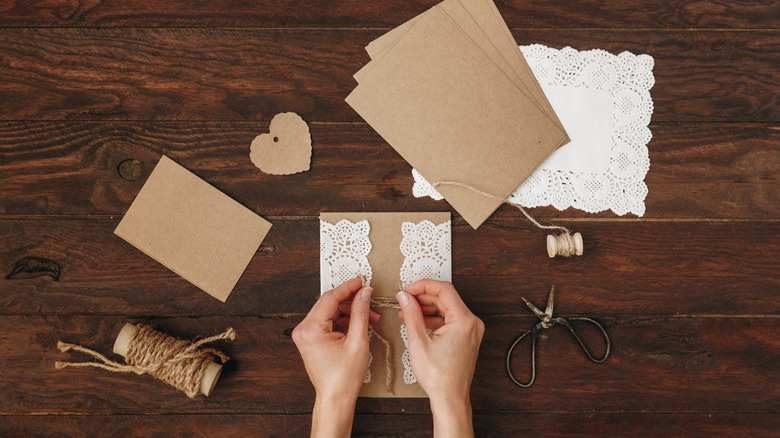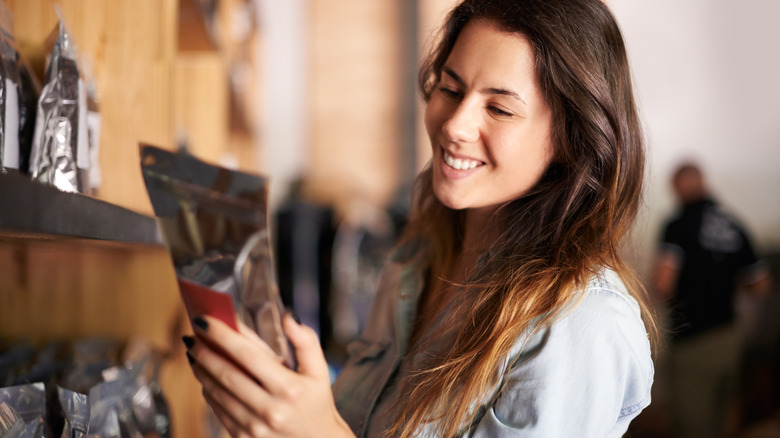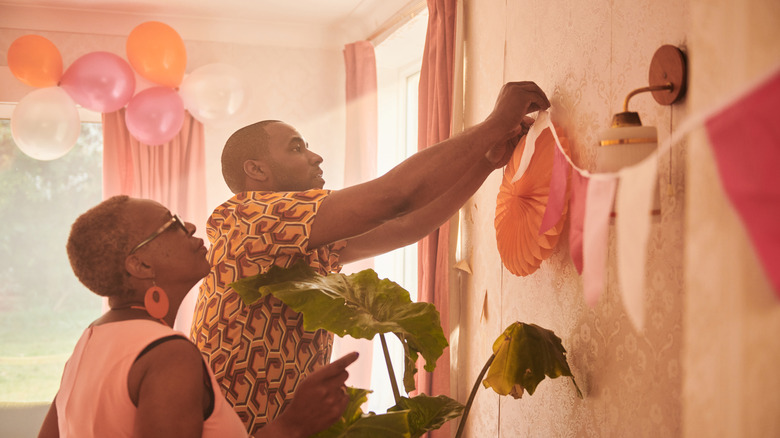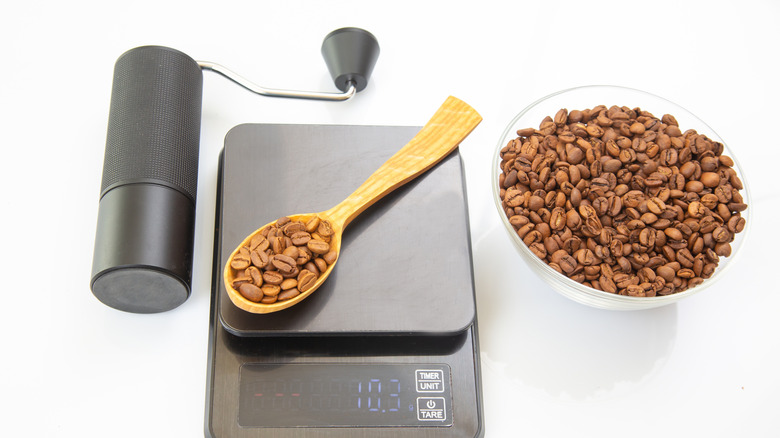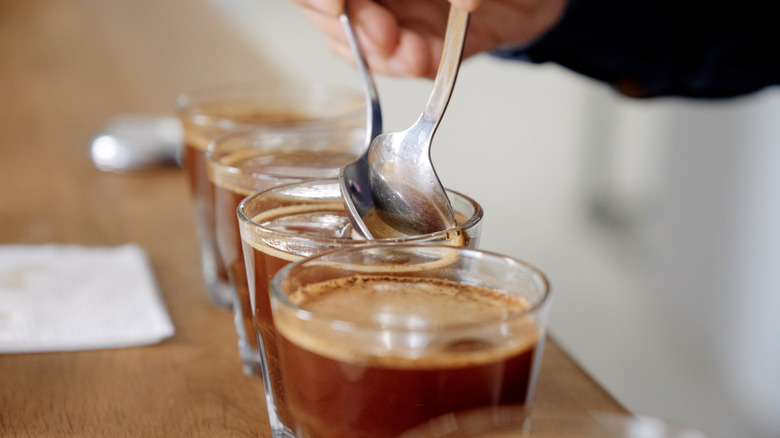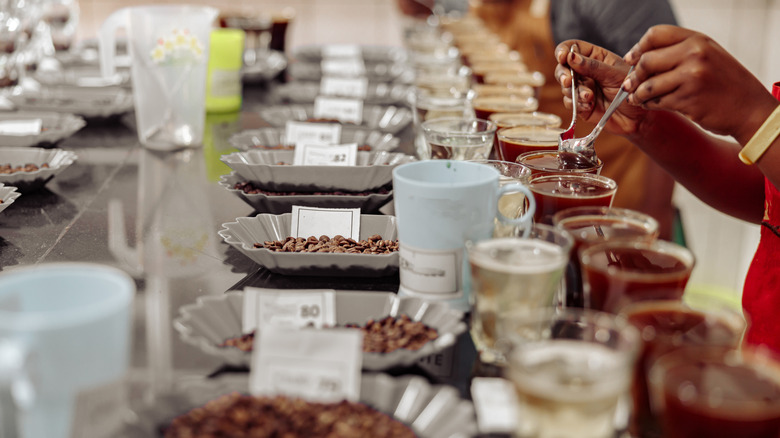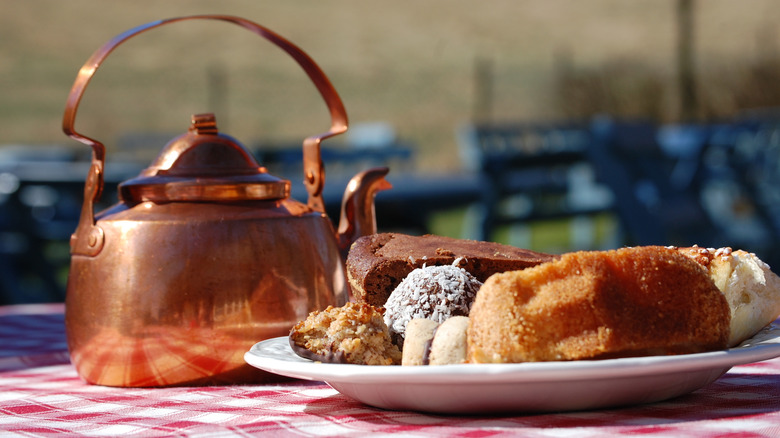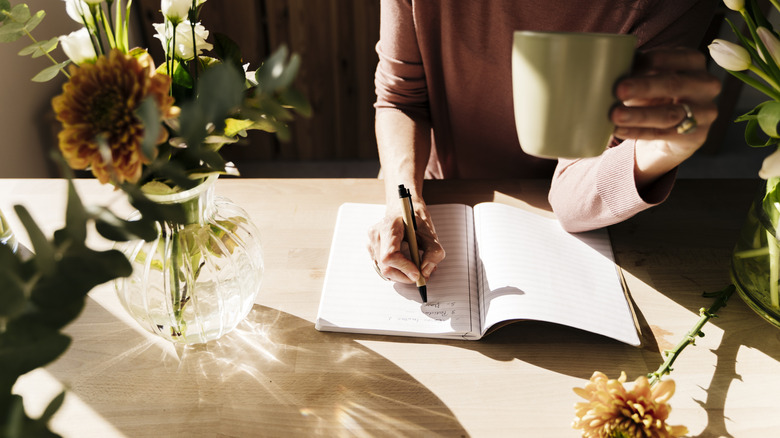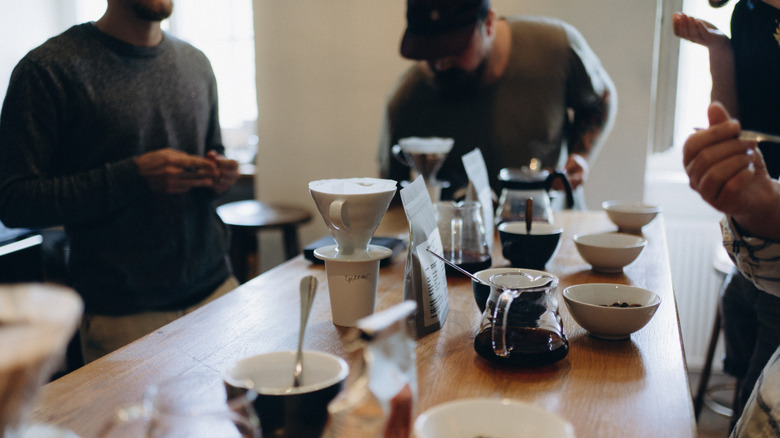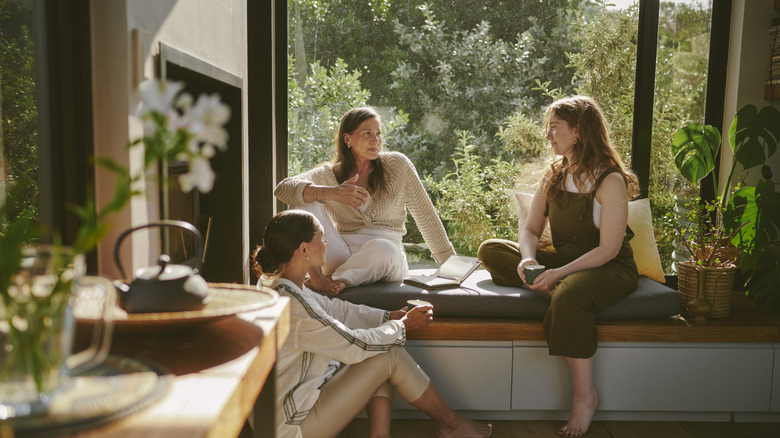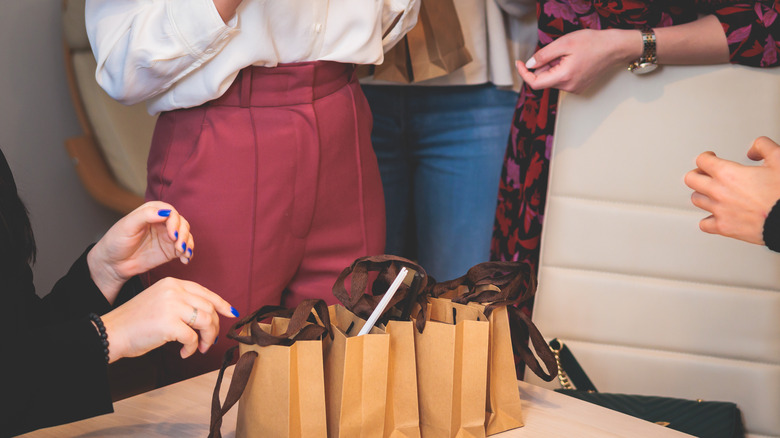How To Host The Ultimate Coffee Tasting
We may receive a commission on purchases made from links.
It's one thing to enjoy a cup of coffee as you're waking up in the morning, but it's another thing to genuinely experience it. A coffee tasting — more commonly referred to as a cupping — is the preferred method in the industry for sampling and testing coffees. It's often used in barista training, in quality control, and to determine flavor profile. Cafés or roasters will hold cuppings to decide which beans they'd like to purchase in bulk. Some people even work full-time as professional elite coffee tasters, otherwise known as "cuppers." But cupping isn't all about business. It can be a fun way to dive deeper into the jittery, caffeinated universe of the world's favorite drink with friends who are just as nerdy about coffee as you are.
At first glance, it seems like cupping is just a bougie term for taking a sip of coffee and determining what it tastes like, but a proper tasting is actually a bit more involved. Tasting coffee works best when a particular ritual is adhered to (don't worry, it doesn't have to be too strict) in order to get a clear picture of the drink's taste, body, and unique nuances.
In this list, I'll use my years of barista training and coffee expertise to break down how you can host a coffee tasting experience from the comfort of your home. I'll teach you how to set up, brew, and ensure that you and your guests have as much fun as possible while taking a deep dive into all that coffee has to offer.
Invite guests
The first step in hosting any sort of gathering is to invite your friends. But unlike a general, casual party, hosting a coffee tasting requires that you don't invite just anyone. Reach out to friends or family who you know have a particular interest in coffee and, preferably, a decent amount of experience in specialty brews. Hosting a cupping with friends who have little interest or experience in the world of coffee would make for an awkward (but potentially funny) experience.
To invite your guests, don't just shoot them a text or quick phone call — go all-out. Start the experience off right with handmade, personalized, coffee-themed invitations and mail them the old-fashioned way. Or, if snail mail is too old school, send a digital invite with plenty of coffee imagery, and maybe even a few puns tossed in for good measure.
As you're sending out your invitations, keep in mind the size of your space and the amount of equipment and coffee you have. Don't overinvite guests and create a cramped, uncomfortable space with not enough to go around. In my experience, the fewer guests, the better. Even just three or four people can be enough for an engaging cupping.
Choose a theme
When picking coffees for your cupping, you'll want to have a bit of rhyme and reason to your choices, instead of just grabbing the first few good bags of beans you come across — there's a ton out there. First, decide how many you want to include. I recommend choosing about five, give or take one. Cupping too many coffees at once can get chaotic, while having only two or three can make the event feel a little lackluster.
There's nothing wrong with choosing a wide variety of different coffees, but if you choose to keep the tasting general and diverse, make sure to include different roast levels and origins, as well as a mix of blends and single-origins. However, those with more extensive coffee expertise might want to stick with a specific theme. Choose from themes like light roast single-origins, beans from only one roaster, or those from only one coffee-growing region. You can even spice up the cupping by choosing coffee blends and creating a game out of who can discern what kind of beans make up each blend — a challenging task, but a fun one to take on, nonetheless.
Set the scene
Coffee cupping — when it's for pleasure and not a business task — is an incredibly relaxing experience. To enhance the comfortable vibe, set the scene in your living room, kitchen, or wherever the cupping will take place for maximum coziness. Be sure to clear enough room so that all your guests can have a spot to sit and relax without having to cram close together. If you have more than five guests, consider setting up multiple stations so that everyone can spread out, instead of hunching over one table of coffee cups.
If you're hosting the cupping in your living room, grab extra pillows for your couch and make sure to tidy up so there's minimal clutter, so all the attention can stay on the cupping. If you'll be tasting the coffees in the kitchen, make a point to stock the room with plenty of cozy seating. Set up lighting around the cupping area that's warm and comfortable, but still bright enough to see what you're doing. Floor lamps and string lights work well for moody-yet-bright lighting. To make the event feel more like a party, make some homemade coffee-themed decorations, like streamers with coffee beans tied to them or flowers made from coffee filters.
Gather all your equipment
Before starting your coffee tasting, you'll need to gather equipment — different gear than you'd need if you were just brewing a pot of coffee from some friends. First, you'll need something to boil water in. Then, you'll need a vessel for the coffees. You can acquire cupping bowls (which are shallow, wide cups that resemble a small soup bowl) if you want to keep your cupping as close to a real coffee industry tasting as possible, but it's not necessary. You can use any mugs that you have lying around, although I find that the wider and shallower, the better. Old sugar bowls are a great swap for cupping bowls, or a rocks glass, as long as the glass is heat-safe.
You'll need to have a grinder and a scale ready to grind your coffee beans and measure them out for each cup. For the freshest-tasting product possible, don't pre-grind your beans. If you have a little bit of grounds left in your grinder from a previous brew, grind a few of the beans to be taste-tested before brewing to clear out the old ones, making sure that no other beans convolute the coffee's taste.
And finally, you'll need some spoons. You can purchase spoons specifically for cupping, but round, deep soup spoons work just as well. As long as you can scoop up a decent amount of coffee with the spoon, you're good to go. Make sure you have plenty at the ready for all your guests to use to discourage double-dipping.
Brew specifically for a cupping
If you're wondering why a coffee brewing apparatus, like a French press, wasn't on the equipment list, let me explain. Baristas and coffee industry experts don't brew coffee using traditional brewing methods when cupping coffee. To achieve the cleanest, most pronounced taste, we brew our beans directly in the mugs or cups that we'll be tasting out of. This method prevents particular brewing techniques from impacting the taste, so all you get is the pure, unadulterated flavor of the beans.
Grind your coffees medium-fine and then place them directly in the bowls or cups that they'll be tasted from. Aim for a ratio of about 12 grams of beans for every 200 milliliters of water. Pour the hot water onto the beans and then wait four minutes, like your mug or cupping bowl is a mini French press. After the four minutes are up, stir the crust that forms on the top and then scrape off any remaining coffee particles. This is a quick, easy process, so don't start brewing far ahead of time; wait until all your guests are gathered together and ready to sample the coffees before you start brewing.
Create an efficient brewing and sampling process
Once the coffee is brewed and it's time to taste, don't let guests crowd around each cup and start sampling willy-nilly. Set up an efficient, streamlined process, either having each guest try all the coffees one at a time, or making sure that only one person is trying each at a time. This is more important if you have five-plus friends at your cupping, where it can get confusing to determine who has already tasted what and whether or not everyone got to sample each coffee.
If you have more than five guests, you might want to set out some single-use cups — like small styrofoam cups — for the tasting. Since everyone will be sampling out of the same cups, you'll need a ton of spoons to ensure that no one is reusing their spoon and germing up the coffees. But even with plenty of spoons, there's no way to make sure that someone didn't absent-mindedly stick their used spoon into a coffee cup. To avoid this, encourage your guests to scoop one sip of coffee into a cup, and then drink from that.
Offer non-coffee drinks and snacks
Make your at-home cupping feel more like a party than a quality-control sampling by offering plenty of drinks and snacks that aren't coffee. Serve small refreshments — like soda, tea, cookies, or charcuterie — before or after the cupping, or even plan a full meal after trying all the coffees. If you plan to serve alcohol, offer it after the cupping experience is over so that everyone's senses are sharp for the tasting.
Alternatively, instead of offering food and drinks before or after the cupping, stretch out the experience a little longer and offer snacks and drinks in between trying each coffee. Plain seltzer water is great for clearing the palate in between samplings, but if you're looking for something a little more fun, offer ginger or lemon drinks for palate-clearing. When it comes to food, salty snacks don't go well with coffee, so avoid serving any chips or nuts during the tasting. Instead, opt for something fruity, chocolatey, and sweet, like pastries. You can even take the snacks a step further and pair donuts with each specific coffee. For example, a dark, rich coffee is delicious with a chocolate donut, while a light, crisp, citrusy brew would taste stellar with a lemon glazed donut.
Write brief bios for each coffee
After you select which coffees you and your guests will be tasting, do a little bit of research to give your at-home cupping a sophisticated touch (and impress your friends, while you're at it). Find out the basics about each brew — the roast level, flavor notes, variety, and the country of origin, specifically. But don't hold back on getting in depth with it. Note which farm or cooperative grew the beans, including some notes about the region, like the altitude and growing conditions. Jot down anything that makes the coffee unique. If it was processed using unconventional methods — perhaps a honey process coffee or an anaerobic (fermented) brew — or if it's an uncommon variety of arabica, your guests would love to know. It's not everyday you get to sip on something extra special.
Organize your info on note cards and then set them out next to each bag of beans, or go paperless and present a slideshow. But only disclose the detailed information about each coffee after the cupping is over. Keep note cards and the bags of coffee hidden from guests' view during the tasting so that the information on flavor notes and origin doesn't influence anyone's taste perception.
Act as a guide
When you're the host of a coffee tasting experience, you should think of yourself as a guide. Your job isn't necessarily to teach your guests about each coffee and tell them what they should be tasting — instead, you should be navigating them through the process and encouraging them to dig deep to uncover specific flavors and unconventional nuances in each drink. Have your guests smell the ground beans before they go in for a sip, preventing anyone from rushing. An at-home coffee cupping can be a relaxing experience, especially when you, as the host, lead everyone through the sipping journey step-by-step, focusing on taking things slow.
Let your guests know ahead of time to bring a notepad and pen (or provide some, if you have spares). Encourage them to take notes as they sip so they don't forget what they tasted by the time the coffee is gone and it's time to discuss. Never make your guests feel like it's a win-or-lose game and that they need to get the coffee's flavor notes, acidity levels, and mouthfeel right. Remind everyone that it's all for fun and the love of coffee, and that different flavors and textures can be detected from person to person. Your job is to make everyone feel comfortable enough to share what they're tasting, no matter what kind of journey their taste buds are taking them on.
Keep the conversation going
Once everyone is done sipping the coffee and sharing their thoughts on each brew, don't just let the event fizzle out awkwardly. Have everyone gather around and share their notes, and compare everyone's notes for each coffee to see if they all had similar ideas and opinions, or if each guest had their own unique takes. Before the tasting, prepare a few questions to ask. Have everyone share their favorite coffee, their least favorite, or something that surprised them about the tasting experience. To spark some coffee-themed debate, have your guests rate and rank each of the brews and then defend their top pick (which is especially entertaining if it's a controversial choice).
If you want to keep the cupping going a little longer after the initial tasting, create a cupping part two — a blind taste-test game. Introduce each coffee and share your note cards on the variety, origin, roast level, and flavor profiles of each, but keep them separate from each brewed cup, so it's a secret which is which. Ask everyone to try all of the coffees again, but this time, have them try to guess which is which based on the information on the bags and your notes. Up the ante by preparing a small coffee-centric prize for whoever gets the most correct, because nothing spices up a party like a little competition.
Send your guests home with a coffee-themed goodie bag
To put the metaphorical cherry on top of your at-home coffee tasting event, send your guests home with something to remember the experience by. Every good party comes complete with party favors, and a coffee-themed party deserves a coffee-themed goodie bag. If you have the time and resources, prepare a small gift bag to give each of your guests as they're leaving, but be sure to keep it a surprise until the night is coming to an end.
If you have leftover beans from the tasting, wrap some up and toss them in a gift bag for your friends to brew at home. Or, find out which beans were their favorite during the cupping, and wrap some up to toss into the bag on the down-low. Add some appropriately-themed trinkets like stickers (this 100-piece collection from BulbaCraft is particularly fun), coffee-flavored candy, a coffee-scented candle or wax melt, and a special spoon. To really drive the theme home, instead of tossing all the goodies in a bag, stuff them into a personalized mug that commemorates your coffee tasting party. Tuck in a handwritten note with some tips for brewing at home or your favorite way to enjoy the beans that you added to the gift and, of course, a heartfelt "thank you" for attending your first at-home coffee tasting.

